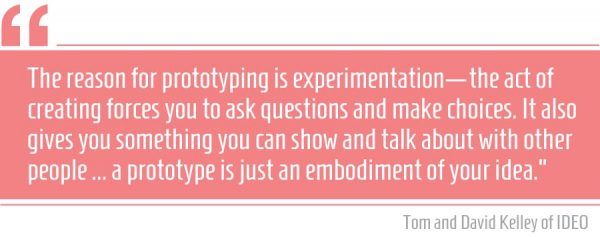If you are just joining, this is part 6 of a series exploring design thinking in strategy development. I encourage you to start at the beginning and read part 1 here.
Prototyping: Trying Out Your Ideas

All of the previous parts in this series have been preparing you to act. Ideas are useless if not acted upon, and prototyping forces you to act. This means taking the insights you have learned about the customer, defining their problem and developing a real-world solution.
What Is Rapid Prototyping?
Design Thinking 2: Rapid Prototypes from Harrison Metal on Vimeo.
Rapid prototyping should be fast and cheap, and pieces from one prototype can be used in another as you gain insights from user feedback. When discussing prototyping, we immediately think of products, but you can also rapid prototype a process or even a business model.
In part 1 of this blog series, you watched a scene from “The Founder” that demonstrates how the McDonald brothers prototyped their kitchen process to speed up hamburger production. This is a perfect example of rapid prototyping. It was cheap: they only used chalk to lay out their kitchen and their employees. It was fast: they could quickly make adjustments based on what they observed.
After finding a method that worked, they invested more resources into trying it out. Once they had the process down, other issues inevitably came up. (This is why you must observe how a new process or product affects your organization and its culture when prototyping. Will you need new training, new roles created or roles eliminated? Just be prepared to make necessary changes.)
Imagine what would have happened if the McDonald brothers had taken a standard approach. Rather than testing a variety of methods quickly, they would have renovated their kitchen based on what they felt was needed. This would have been costly, time-consuming and ineffective. Sadly, this is how many businesses operate today.
7 Tips for Rapid Prototyping
Here are seven tips to use for rapid prototyping:
- Allow enough time.
- Make sure you have the necessary equipment and space for prototype development. If you are working on refining a process, then set aside a meeting room or warehouse.
- Develop the prototype.
- Avoid polishing prototypes as user feedback may result in drastic changes.
- Arrange for users to test the prototype.
- Record video of user interactions of the prototype.
- Do not get emotionally attached to your prototypes. The value is not in the prototype, but in what you learn from testing with customers.
Lo-Fi and Hi-Fi Prototypes
Within rapid prototyping, your teams can choose between low-fidelity and high-fidelity prototypes. Before they do, consider the pros and cons of both.
- Lo-Fi Prototypes: Lo-fi prototypes are made with materials that may not be up to scale or that are not intended for final use. Examples of lo-fi prototypes could be storyboarding a process or fulfilling a process manually, even though it would eventually be automated.

- Hi-Fi Prototypes: Hi-fi prototypes are made with production-ready tools and require more advanced skills when developing the product. Interactions are higher and create a more realistic feel compared to lo-fi prototypes.

What Is Customer Validation?
Similar to how startups get funding from venture capitals, you need consumer validation in the marketplace. Consumer validation comes in many shapes and sizes. It could come in the form of purchasing a test product, signing up for a service or giving you a piece of information. Notice how the customer needs to buy, sign up or give. That is because to validate success, a consumer needs to actually invest in a product. Anyone will take anything for free and tell you that they like it, but it takes more to separate the consumer from the dollar.
2 Ways to Validate Your Prototype
- Limited release: Teams could introduce a limited release for a new product to determine whether or not it is desired and what consumers are willing to spend. Small start-ups can take advantage of platforms that exist in the marketplace, such as Indiegogo, to test for consumer acceptance. Large organizations can also take advantage of these tools to test how a product will be received and determine if it is worth scaling up.
- Gathering personal information: Teams could test an idea by building a website for your product or service and requesting info from the user to notify them on upcoming releases. Because users today are not ready to share so easily, their willingness to provide info to stay up-to-date on news could be viewed as a validation of interest.
Demonstrating Prototypes
Teams shouldn’t stop at just one prototype. Build and test as many as possible within the time and budget allowed. Each week, do a read out and demonstrate the prototypes. Present what worked and what didn’t, along with any feedback. As we learned in ideation, ideas feed off of one another. Take advantage of this, and encourage your teams to apply what they have learned from each other into their prototyping processes.
Part 7 will look at one of the most important aspects of the design thinking process: testing. Until then, if you have any questions, just ask our experts.
